Effect of Regenerative Braking on Battery Life
Abstract
:1. Introduction
2. Literature Review
2.1. Regenerative Braking
2.1.1. Different Regenerative Braking Strategies
2.1.2. Combined Regenerative Braking and Fuzzy Logics System
2.1.3. Other Regenerative Braking System Strategies
2.2. State of Charge (SOC) of Battery
2.2.1. Types of SOC Estimation Techniques
- (a)
- Direct measurement: This method correlates with voltage and impedance of the battery.
- (b)
- Book-keeping estimation: This method integrates the charging or discharge current over the period of charging or discharging duration to calculate SOC.
- (c)
- Adaptive systems: The adaptive systems are self-designing and can modify the SOC for various discharging situations automatically. Adaptive methods for SOC estimation have been created in a variety of ways.
- (d)
- Hybrid methods: In hybrid models, the benefits of each SOC estimation strategy are merged to produce a globally optimal estimation performance. The literature indicates that hybrid strategies provide accurate SOC estimation as compared with individual methodologies [39].
| Category | Model | Characteristics |
|---|---|---|
| Direct measurement [44,45,46,47,48,49] |
|
|
| Book-keeping estimation [37,50,51,52,53] |
|
|
| Adaptive systems [48,54] |
|
|
| Hybrid methods [55,56,57,58] |
|
|
2.2.2. SOC Estimation Technique in Modern Vehicles
2.3. State of Health (SOH) of Battery
2.4. Effect of Regenerative Braking on the Life of Battery
3. Conclusions
4. Future Work
Author Contributions
Funding
Data Availability Statement
Conflicts of Interest
References
- Yoong, M.K.; Gan, Y.H.; Gan, G.D.; Leong, C.K.; Phuan, Z.Y.; Cheah, B.K.; Chew, K.W. Studies of regenerative braking in electric vehicle. In Proceedings of the 2010 IEEE Conference on Sustainable Utilization and Development in Engineering and Technology, Kuala Lumpur, Malaysia, 20–21 November 2010; IEEE: Miami, FL, USA, 2010; pp. 40–45. [Google Scholar]
- Dixon, J.W.; Ortuzar, M.E. Ultracapacitors+ DC-DC converters in regenerative braking system. IEEE Aerosp. Electron. Syst. Mag. 2002, 17, 16–21. [Google Scholar] [CrossRef]
- Piller, S.; Perrin, M.; Jossen, A. Methods for state-of-charge determination and their applications. J. Power Source 2001, 96, 113–120. [Google Scholar] [CrossRef]
- Hu, C.; Youn, B.D.; Chung, J. A multiscale framework with extended Kalman filter for lithium-ion battery SOC and capacity estimation. Appl. Energy 2012, 92, 694–704. [Google Scholar] [CrossRef]
- Venugopal, P. State-of-Health estimation of li-ion batteries in electric vehicle using IndRNN under variable load condition. Energies 2019, 12, 4338. [Google Scholar] [CrossRef] [Green Version]
- Qin, T.; Zeng, S.; Guo, J.; Skaf, Z. State of health estimation of li-ion batteries with regeneration phenomena: A similar rest time-based prognostic framework. Symmetry 2016, 9, 4. [Google Scholar] [CrossRef] [Green Version]
- Lipu, M.H.; Hannan, M.A.; Hussain, A.; Hoque, M.M.; Ker, P.J.; Saad, M.M.; Ayob, A. A review of state of health and remaining useful life estimation methods for lithium-ion battery in electric vehicles: Challenges and recommendations. J. Clean. Prod. 2018, 205, 115–133. [Google Scholar] [CrossRef]
- Cikanek, S.R.; Bailey, K.E. Regenerative braking system for a hybrid electric vehicle. In Proceedings of the 2002 American Control Conference (IEEE Cat. No. CH37301), Anchorage, AK, USA, 8–10 May 2002; IEEE: Miami, FL, USA, 2010; Volume 4, pp. 3129–3134. [Google Scholar]
- Panagiotidis, M.; Delagrammatikas, G.; Assanis, D. Development and Use of a Regenerative Braking Model for a Parallel Hybrid Electric Vehicle; SAE Transactions: Warrendale, PA, USA, 2000; pp. 1180–1191. [Google Scholar]
- Gao, Y.; Chen, L.; Ehsani, M. Investigation of the Effectiveness of Regenerative Braking for EV and HEV; SAE Transactions: Warrendale, PA, USA, 1999; pp. 3184–3190. [Google Scholar]
- Gao, Y.; Chu, L.; Ehsani, M. Design and control principles of hybrid braking system for EV, HEV and FCV. In Proceedings of the 2007 IEEE Vehicle Power and Propulsion Conference, Arlington, TX, USA, 9–12 September 2007; IEEE: Miami, FL, USA, 2007; pp. 384–391. [Google Scholar]
- Cacciatori, E.; Bonnet, B.; Vaughan, N.D.; Burke, M.; Price, D.; Wejrzanowski, K. Regenerative braking strategies for a parallel hybrid powertrain with torque controlled IVT. SAE Tech. Pap. 2005, 1, 3826. [Google Scholar]
- Gao, Y.; Ehsani, M. Electronic Braking System of EV And HEV-Integration of Regenerative Braking, Automatic Braking Force Control and ABS; SAE Transactions: Warrendale, PA, USA, 2001; pp. 576–582. [Google Scholar]
- Tur, O.; Ustun, O.; Tuncay, R.N. An introduction to regenerative braking of electric vehicles as anti-lock braking system. In Proceedings of the 2007 IEEE Intelligent Vehicles Symposium, Istanbul, Turkey, 13–15 June 2007; IEEE: Miami, FL, USA, 2007; pp. 944–948. [Google Scholar]
- Guo, J.; Wang, J.; Cao, B. Regenerative braking strategy for electric vehicles. In Proceedings of the 2009 IEEE Intelligent Vehicles Symposium, Xi’an, China, 3–5 June 2009; IEEE: Miami, FL, USA, 2009; pp. 864–868. [Google Scholar]
- Yeo, H.; Hwang, S.; Kim, H. Regenerative braking algorithm for a hybrid electric vehicle with CVT ratio control. Proc. Inst. Mech. Eng. Part D J. Automob. Eng. 2006, 220, 1589–1600. [Google Scholar] [CrossRef]
- Qiu, C.; Wang, G.; Meng, M.; Shen, Y. A novel control strategy of regenerative braking system for electric vehicles under safety critical driving situations. Energy 2018, 149, 329–340. [Google Scholar] [CrossRef]
- Nian, X.; Peng, F.; Zhang, H. Regenerative braking system of electric vehicle driven by brushless DC motor. IEEE Trans. Ind. Electron. 2014, 61, 5798–5808. [Google Scholar] [CrossRef]
- Chuanwei, Z. Experimental Research on H∞ Control for Regenerative Braking of Electric Vehicle. In Proceedings of the 2010 International Conference on Electrical and Control Engineering, Wuhan, China, 25–27 June 2010; IEEE: Miami, FL, USA, 2010; pp. 940–943. [Google Scholar]
- Ye, M.; Bai, Z.; Cao, B. Robust sliding model control for regenerative braking of electric vehicle. In Proceedings of the 2006 CES/IEEE 5th International Power Electronics and Motion Control Conference, Shanghai, China, 14–16 August 2006; IEEE: Miami, FL, USA, 2006; Volume 3, pp. 1–4. [Google Scholar]
- Cao, J.; Cao, B.; Xu, P.; Bai, Z. Regenerative-braking sliding mode control of electric vehicle based on neural network identification. In Proceedings of the 2008 IEEE/ASME International Conference on Advanced Intelligent Mechatronics, Xi’an, China, 2–5 July 2008; IEEE: Miami, FL, USA, 2008; pp. 1219–1224. [Google Scholar]
- Cao, J.; Cao, B.; Chen, W.; Xu, P. Neural network self-adaptive PID control for driving and regenerative braking of electric vehicle. In Proceedings of the 2007 IEEE International Conference on Automation and Logistics, Shandong, China, 18–21 August 2007; IEEE: Miami, FL, USA, 2007; pp. 2029–2034. [Google Scholar]
- Gao, H.; Gao, Y.; Ehsani, M. A neural network based SRM drive control strategy for regenerative braking in EV and HEV. In Proceedings of the IEMDC 2001. IEEE International Electric Machines and Drives Conference (Cat. No. 01EX485), Cambridge, MA, USA, 17–20 June 2001; IEEE: Miami, FL, USA, 2001; pp. 571–575. [Google Scholar]
- Xu, G.; Li, W.; Xu, K.; Song, Z. An intelligent regenerative braking strategy for electric vehicles. Energies. 2011, 4, 1461–1477. [Google Scholar] [CrossRef] [Green Version]
- Li, X.; Xu, L.; Hua, J.; Li, J.; Ouyang, M. Regenerative braking control strategy for fuel cell hybrid vehicles using fuzzy logic. In Proceedings of the 2008 International Conference on Electrical Machines and Systems, Wuhan, China, 17–20 October 2008; IEEE: Miami, FL, USA, 2010; pp. 2712–2716. [Google Scholar]
- Zhang, J.M.; Song, B.Y.; Cui, S.M.; Ren, D.B. Fuzzy logic approach to regenerative braking system. In Proceedings of the 2009 International Conference on Intelligent Human-Machine Systems and Cybernetics, Hangzhou, China, 26–27 August 2009; IEEE: Miami, FL, USA, 2009; Volume 1, pp. 451–454. [Google Scholar]
- Peng, D.; Zhang, Y.; Yin, C.L.; Zhang, J.W. Combined control of a regenerative braking and antilock braking system for hybrid electric vehicles. Int. J. Automot. Technol. 2008, 9, 749–757. [Google Scholar] [CrossRef]
- Paul, D.; Velenis, E.; Cao, D.; Dobo, T. Optimal μ-Estimation-Based regenerative braking strategy for an AWD HEV. IEEE Trans. Transp. Electrif. 2016, 3, 249–258. [Google Scholar] [CrossRef]
- Zhang, J.; Lv, C.; Gou, J.; Kong, D. Cooperative control of regenerative braking and hydraulic braking of an electrified passenger car. Proc. Inst. Mech. Eng. Part D J. Automob. Eng. 2012, 226, 1289–1302. [Google Scholar] [CrossRef]
- Ahn, J.K.; Jung, K.H.; Kim, D.H.; Jin, H.B.; Kim, H.S.; Hwang, S.H. Analysis of a regenerative braking system for hybrid electric vehicles using an electro-mechanical brake. Int. J. Automot. Technol. 2009, 10, 229–234. [Google Scholar] [CrossRef]
- Li, L.; Wang, X.; Xiong, R.; He, K.; Li, X. AMT downshifting strategy design of HEV during regenerative braking process for energy conservation. Appl. Energy 2016, 183, 914–925. [Google Scholar] [CrossRef]
- Junzhi, Z.; Yutong, L.; Chen, L.; Ye, Y. New regenerative braking control strategy for rear-driven electrified minivans. Energy Convers. Manag. 2014, 82, 135–145. [Google Scholar] [CrossRef]
- Bailey, K.E.; Powell, B.K.; Villec, G.N. ABS/traction assist/regenerative braking application of hardware-in-the-loop. In Proceedings of the 1998 American Control Conference. ACC (IEEE Cat. No. 98CH36207), Philadelphia, PA, USA, 26 June 1998; IEEE: Miami, FL, USA, 1998; Volume 1, pp. 503–507. [Google Scholar]
- Ko, J.; Ko, S.; Son, H.; Yoo, B.; Cheon, J.; Kim, H. Development of brake system and regenerative braking cooperative control algorithm for automatic-transmission-based hybrid electric vehicles. IEEE Trans. Veh. Technol. 2014, 64, 431–440. [Google Scholar] [CrossRef]
- Lv, C.; Zhang, J.; Li, Y.; Yuan, Y. Mechanism analysis and evaluation methodology of regenerative braking contribution to energy efficiency improvement of electrified vehicles. Energy Convers. Manag. 2015, 92, 469–482. [Google Scholar] [CrossRef]
- Qiu, C.; Wang, G. New evaluation methodology of regenerative braking contribution to energy efficiency improvement of electric vehicles. Energy Convers. Manag. 2016, 119, 389–398. [Google Scholar] [CrossRef]
- Baccouche, I.; Jemmali, S.; Mlayah, A.; Manai, B.; Amara, N.E. Implementation of an improved Coulomb-counting algorithm based on a piecewise SOC-OCV relationship for SOC estimation of li-IonBattery. arXiv 2018, arXiv:1803.10654. [Google Scholar]
- Sauer, D.U.; Bopp, G.; Jossen, A.; Garche, J.; Rothert, M.; Wollny, M. State of Charge—What do we really speak about. In Proceedings of the 21st International Telecommunications Energy Conference, Kopenhagen, Denmark, 9 June 1999; pp. 6–9. [Google Scholar]
- Chiasson, J.; Vairamohan, B. Estimating the state of charge of a battery. In Proceedings of the 2003 American Control Conference, Denver, CO, USA, 4–6 June 2003; IEEE: Miami, FL, USA, 2003; Volume 4, pp. 2863–2868. [Google Scholar]
- Jia, C.; Zhou, J.; He, H.; Li, J.; Wei, Z.; Li, K.; Shi, M. A novel energy management strategy for hybrid electric bus with fuel cell health and battery thermal-and health-constrained awareness. Energy 2023, 271, 127105. [Google Scholar] [CrossRef]
- Zhang, R.; Xia, B.; Li, B.; Cao, L.; Lai, Y.; Zheng, W.; Wang, H.; Wang, W. State of the art of lithium-ion battery SOC estimation for electrical vehicles. Energies 2018, 11, 1820. [Google Scholar] [CrossRef] [Green Version]
- Hannan, M.A.; Lipu, M.H.; Hussain, A.; Mohamed, A. A review of lithium-ion battery state of charge estimation and management system in electric vehicle applications: Challenges and recommendations. Renew. Sustain. Energy Rev. 2017, 78, 834–854. [Google Scholar] [CrossRef]
- Yanhui, Z.; Wenji, S.; Shili, L.; Jie, L.; Ziping, F. A critical review on state of charge of batteries. J. Renew. Sustain. Energy 2013, 5, 021403. [Google Scholar] [CrossRef]
- Ng, K.S.; Moo, C.S.; Chen, Y.P.; Hsieh, Y.C. State-of-charge estimation for lead-acid batteries based on dynamic open-circuit voltage. In Proceedings of the 2008 IEEE 2nd International Power and Energy Conference, Johor Bahru, Malaysia, 1–3 December 2008; IEEE: Miami, FL, USA, 2008; pp. 972–976. [Google Scholar]
- Berecibar, M.; Gandiaga, I.; Villarreal, I.; Omar, N.; Van Mierlo, J.; Van den Bossche, P. Critical review of state of health estimation methods of Li-ion batteries for real applications. Renew. Sustain. Energy Rev. 2016, 56, 572–587. [Google Scholar] [CrossRef]
- Zhang, J.; Xia, C. State-of-charge estimation of valve regulated lead acid battery based on multi-state Unscented Kalman Filter. Int. J. Electr. Power Energy Syst. 2011, 33, 472–476. [Google Scholar] [CrossRef]
- Anbuky, A.H.; Pascoe, P.E. VRLA battery state-of-charge estimation in telecommunication power systems. IEEE Trans. Ind. Electron. 2000, 47, 565–573. [Google Scholar] [CrossRef]
- Ran, L.; Junfeng, W.; Haiying, W.; Gechen, L. Prediction of state of charge of lithium-ion rechargeable battery with electrochemical impedance spectroscopy theory. In Proceedings of the 2010 5th IEEE Conference on Industrial Electronics and Applications, Taichung, Taiwan, 15–17 June 2010; IEEE: Miami, FL, USA, 2010; pp. 684–688. [Google Scholar]
- Huet, F. A review of impedance measurements for determination of the state-of-charge or state-of-health of secondary batteries. J. Power Source 1998, 70, 59–69. [Google Scholar] [CrossRef]
- Kim, J.; Cho, B.H. State-of-charge estimation and state-of-health prediction of a Li-ion degraded battery based on an EKF combined with a per-unit system. IEEE Trans. Veh. Technol. 2011, 60, 4249–4260. [Google Scholar] [CrossRef]
- Xie, J.; Ma, J.; Bai, K. Enhanced coulomb counting method for state-of-charge estimation of lithium-ion batteries based on peukert’s law and coulombic efficiency. J. Power Electron. 2018, 18, 910–922. [Google Scholar]
- Lee, S.; Kim, J.; Lee, J.; Cho, B.H. State-of-charge and capacity estimation of lithium-ion battery using a new open-circuit voltage versus state-of-charge. J. Power Source 2008, 185, 1367–1373. [Google Scholar] [CrossRef]
- Baccouche, I.; Mlayah, A.; Jemmali, S.; Manai, B.; Amara, N.E. $ Implementation of a Coulomb counting algorithm for SOC estimation of Li-Ion battery for multimedia applications. In Proceedings of the 2015 IEEE 12th International Multi-Conference on Systems, Signals & Devices (SSD15), Mahdia, Tunisia, 16–19 March 2015; IEEE: Miami, FL, USA, 2015; pp. 1–6. [Google Scholar]
- Jeong, Y.M.; Cho, Y.K.; Ahn, J.H.; Ryu, S.H.; Lee, B.K. Enhanced Coulomb counting method with adaptive SOC reset time for estimating OCV. In Proceedings of the 2014 IEEE Energy Conversion Congress and Exposition (ECCE), Pittsburgh, PA, USA, 14–18 September 2014; IEEE: Miami, FL, USA, 2014; pp. 1313–1318. [Google Scholar]
- How, D.N.; Hannan, M.A.; Lipu, M.H.; Ker, P.J. State of charge estimation for lithium-ion batteries using model-based and data-driven methods: A review. IEEE Access 2019, 7, 136116–136136. [Google Scholar] [CrossRef]
- Plett, G.L. Kalman-filter SOC estimation for LiPB HEV cells. In Proceedings of the 19th International Battery, Hybrid and Fuel Cell Electric Vehicle Symposium & Exhibition (EVS19), Busan, Republic of Korea, 19–21 October 2002; pp. 527–538. [Google Scholar]
- Sepasi, S.; Ghorbani, R.; Liaw, B.Y. Improved extended Kalman filter for state of charge estimation of battery pack. J. Power Source 2014, 255, 368–376. [Google Scholar] [CrossRef]
- Peng, S.; Chen, C.; Shi, H.; Yao, Z. State of charge estimation of battery energy storage systems based on adaptive unscented Kalman filter with a noise statistics estimator. IEEE Access 2017, 5, 13202–13212. [Google Scholar] [CrossRef]
- Liu, L.; Chen, Z.; Wang, C.; Lin, F.; Wang, H. Integrated system identification and state-of-charge estimation of battery systems. IEEE Trans. Energy Convers. 2012, 28, 12–23. [Google Scholar] [CrossRef]
- Kim, M.J.; Chae, S.H.; Moon, Y.K. Adaptive Battery State-of-Charge Estimation Method for Electric Vehicle Battery Management System. In Proceedings of the 2020 International SoC Design Conference (ISOCC), Yeosu, Republic of Korea, 21–24 October 2020; IEEE: Miami, FL, USA, 2020; pp. 288–289. [Google Scholar]
- El Din, M.S.; Hussein, A.A.; Abdel-Hafez, M.F. Improved battery SOC estimation accuracy using a modified UKF with an adaptive cell model under real EV operating conditions. IEEE Trans. Transp. Electrif. 2018, 4, 408–417. [Google Scholar] [CrossRef]
- He, Z.; Yang, Z.; Cui, X.; Li, E. A method of state-of-charge estimation for EV power lithium-ion battery using a novel adaptive extended Kalman filter. IEEE Trans. Veh. Technol. 2020, 69, 14618–14630. [Google Scholar] [CrossRef]
- Wang, J.; Cao, B.; Chen, Q.; Wang, F. Combined state of charge estimator for electric vehicle battery pack. Control. Eng. Pract. 2007, 15, 1569–1576. [Google Scholar] [CrossRef]
- Sun, F.; Hu, X.; Zou, Y.; Li, S. Adaptive unscented Kalman filtering for state of charge estimation of a lithium-ion battery for electric vehicles. Energy 2011, 36, 3531–3540. [Google Scholar] [CrossRef]
- Yang, D.; Wang, Y.; Pan, R.; Chen, R.; Chen, Z. A neural network-based state-of-health estimation of lithium-ion battery in electric vehicles. Energy Procedia 2017, 105, 2059–2064. [Google Scholar] [CrossRef]
- Lin, H.T.; Liang, T.J.; Chen, S.M. Estimation of battery state of health using probabilistic neural network. IEEE Trans. Ind. Inform. 2012, 9, 679–685. [Google Scholar] [CrossRef]
- Shi, G.; Chen, S.; Yuan, H.; You, H.; Wang, X.; Dai, H.; Wei, X. Determination of optimal indicators based on statistical analysis for the state of health estimation of a Lithium-ion battery. Front. Energy Res. 2021, 9, 262. [Google Scholar] [CrossRef]
- Xu, Z.; Yan, X.; Huang, B.; Wang, Y.; Dong, D.; Liu, Z. The Effect of Charge Behavior on Lithium Battery SOH. In Proceedings of the 2020 3rd International Conference on Advanced Electronic Materials, Computers and Software Engineering (AEMCSE), Shenzhen, China, 6–8 March 2020; IEEE: Miami, FL, USA, 2020; pp. 658–661. [Google Scholar]
- Kim, T.; Qiao, W.; Qu, L. Online SOC and SOH estimation for multicell lithium-ion batteries based on an adaptive hybrid battery model and sliding-mode observer. In Proceedings of the 2013 IEEE Energy Conversion Congress and Exposition, Denver, CO, USA, 15–19 September 2013; IEEE: Miami, FL, USA, 2013; pp. 292–298. [Google Scholar]
- Dong, G.; Han, W.; Wang, Y. Dynamic Bayesian Network-Based Lithium-Ion Battery Health Prognosis for Electric Vehicles. IEEE Trans. Ind. Electron. 2020, 68, 10949–10958. [Google Scholar] [CrossRef]
- Lin, C.P.; Cabrera, J.; Denis, Y.W.; Yang, F.; Tsui, K.L. SOH estimation and SOC recalibration of lithium-ion battery with incremental capacity analysis & cubic smoothing spline. J. Electrochem. Soc. 2020, 167, 090537. [Google Scholar]
- Mater, I.J. Effect of ambient temperature, C-rate and SOH on the charge and discharge performance and self-temperature of LCO batteries. Int. J. Electroactive Mater. 2021, 9, 1. [Google Scholar]
- Diao, W.; Jiang, J.; Zhang, C.; Liang, H.; Pecht, M. Energy state of health estimation for battery packs based on the degradation and inconsistency. Energy Procedia 2017, 142, 3578–3583. [Google Scholar] [CrossRef]
- Torai, S.; Nakagomi, M.; Yoshitake, S.; Yamaguchi, S.; Oyama, N. State-of-health estimation of LiFePO4/graphite batteries based on a model using differential capacity. J. Power Source 2016, 306, 62–69. [Google Scholar] [CrossRef]
- Balagopal, B.; Chow, M.Y. The state of the art approaches to estimate the state of health (SOH) and state of function (SOF) of lithium Ion batteries. In Proceedings of the 2015 IEEE 13th International Conference on Industrial Informatics (INDIN), Cambridge, UK, 22–24 July 2015; IEEE: Miami, FL, USA, 2015; pp. 1302–1307. [Google Scholar]
- Moura, S.J.; Chaturvedi, N.A.; Krstić, M. PDE estimation techniques for advanced battery management systems-Part II: SOH identification. In Proceedings of the 2012 American Control Conference (ACC), Montreal, QC, Canada, 27–29 June 2012; IEEE: Miami, FL, USA, 2012; pp. 566–571. [Google Scholar]
- Cacciato, M.; Nobile, G.; Scarcella, G.; Scelba, G. Real-time model-based estimation of SOC and SOH for energy storage systems. IEEE Trans. Power Electron. 2016, 32, 794–803. [Google Scholar] [CrossRef]
- Hatzell, K.B.; Sharma, A.; Fathy, H.K. A survey of long-term health modeling, estimation, and control of lithium-ion batteries: Challenges and opportunities. In Proceedings of the 2012 American Control Conference (ACC), Montreal, QC, Canada, 27–29 June 2012; IEEE: Miami, FL, USA, 2012; pp. 584–591. [Google Scholar]
- Cuma, M.U.; Koroglu, T. A comprehensive review on estimation strategies used in hybrid and battery electric vehicles. Renew. Sustain. Energy Rev. 2015, 42, 517–531. [Google Scholar] [CrossRef]
- Lee, P.Y.; Kim, J. Impact analysis of deterioration and SOH estimation based on multiple regression analysis. In Proceedings of the 2019 IEEE Transportation Electrification Conference and Expo, Asia-Pacific (ITEC Asia-Pacific), Jeju, Republic of Korea, 8–10 May 2019; IEEE: Miami, FL, USA, 2019; pp. 1–6. [Google Scholar]
- Fang, L.; Li, J.; Peng, B. Online Estimation and Error Analysis of both SOC and SOH of Lithium-ion Battery based on DEKF Method. Energy Procedia 2019, 158, 3008–3013. [Google Scholar] [CrossRef]
- Anselma, P.G.; Kollmeyer, P.; Lempert, J.; Zhao, Z.; Belingardi, G.; Emadi, A. Battery state-of-health sensitive energy management of hybrid electric vehicles: Lifetime prediction and ageing experimental validation. Appl. Energy 2021, 285, 116440. [Google Scholar] [CrossRef]
- Bloom, I.; Cole, B.W.; Sohn, J.J.; Jones, S.A.; Polzin, E.G.; Battaglia, V.S.; Henriksen, G.L.; Motloch, C.; Richardson, R.; Unkelhaeuser, T.; et al. An accelerated calendar and cycle life study of Li-ion cells. J. Power Source 2001, 101, 238–247. [Google Scholar] [CrossRef]
- Anselma, P.G.; Kollmeyer, P.; Belingardi, G.; Emadi, A. Multi-objective hybrid electric vehicle control for maximizing fuel economy and battery lifetime. In Proceedings of the 2020 IEEE Transportation Electrification Conference & Expo (ITEC), Detroit, MI, USA, 21–23 June 2020; IEEE: Miami, FL, USA, 2020; pp. 1–6. [Google Scholar]
- Yang, S.; Zhang, C.; Jiang, J.; Zhang, W.; Zhang, L.; Wang, Y. Review on state-of-health of lithium-ion batteries: Characterizations, estimations and applications. J. Clean. Prod. 2021, 314, 128015. [Google Scholar] [CrossRef]
- Wang, L.; Pan, C.; Liu, L.; Cheng, Y.; Zhao, X. On-board state of health estimation of LiFePO4 battery pack through differential voltage analysis. Appl. Energy 2016, 168, 465–472. [Google Scholar] [CrossRef]
- Dalal, M.; Ma, J.; He, D. Lithium-ion battery life prognostic health management system using particle filtering framework. Proc. Inst. Mech. Eng. Part O: J. Risk Reliab. 2011, 225, 81–90. [Google Scholar] [CrossRef]
- Saha, B.; Goebel, K. Modeling Li-ion battery capacity depletion in a particle filtering framework. In Proceedings of the Annual Conference of the PHM Society, San Diego, CA, USA, 29 November–2 December; 2021; Volume 1. Available online: http://www.papers.phmsociety.org/index.php/phmconf/article/view/1614 (accessed on 5 July 2023).
- Sarıkurt, T.; Ceylan, M.; Balikçi, A. An analytical battery state of health estimation method. In Proceedings of the 2014 IEEE 23rd International Symposium on Industrial Electronics (ISIE), Istanbul, Turkey, 1–4 June 2014; IEEE: Miami, FL, USA, 2014; pp. 1605–1609. [Google Scholar]
- Goebel, K.; Saha, B.; Saxena, A.; Celaya, J.R.; Christophersen, J.P. Prognostics in battery health management. IEEE Instrum. Meas. Mag. 2008, 11, 33–40. [Google Scholar] [CrossRef]
- Keil, P.; Jossen, A. Aging of lithium-ion batteries in electric vehicles: Impact of regenerative braking. World Electr. Veh. J. 2015, 7, 41–51. [Google Scholar] [CrossRef] [Green Version]
- Keil, P.; Jossen, A. Impact of dynamic driving loads and regenerative braking on the aging of lithium-ion batteries in electric vehicles. J. Electrochem. Soc. 2017, 164, A3081. [Google Scholar] [CrossRef]
- Huang, J.; Qin, D.; Peng, Z. Effect of energy-regenerative braking on electric vehicle battery thermal management and control method based on simulation investigation. Energy Convers. Manag. 2015, 105, 1157–1165. [Google Scholar] [CrossRef]
- Carrilero, I.; Ansean, D.; Viera, J.C.; Fernandez, Y.; Pereirinha, P.G.; González, M. Impact of fast-charging and regenerative braking in LiFePO4 batteries for electric bus applications. In Proceedings of the 2017 IEEE Vehicle Power and Propulsion Conference (VPPC), Belfort, France, 11–14 December 2017; IEEE: Miami, FL, USA, 2017; pp. 1–6. [Google Scholar]
- Asif, R.M.; Yousaf, A.; Rehman, A.U.; Shabbir, N.; Sadiq, M.T. Increase battery time by improvement in regenerative braking with storage system in hybrid vehicle. J. Appl. Emerg. Sci. 2019, 9, 53. [Google Scholar] [CrossRef]
- Wu, J.; Wang, X.; Li, L.; Du, Y. Hierarchical control strategy with battery aging consideration for hybrid electric vehicle regenerative braking control. Energy 2018, 145, 301–312. [Google Scholar] [CrossRef]
- Long, B.; Lim, S.T.; Bai, Z.F.; Ryu, J.H.; Chong, K.T. Energy management and control of electric vehicles, using hybrid power source in regenerative braking operation. Energies 2014, 7, 4300–4315. [Google Scholar] [CrossRef] [Green Version]
- Cao, B.; Bai, Z.; Zhang, W. Research on control for regenerative braking of electric vehicle. In Proceedings of the IEEE International Conference on Vehicular Electronics and Safety, Xi’an, China, 14–16 October 2005; IEEE: Miami, FL, USA, 2005; pp. 92–97. [Google Scholar]
- Zhu, Y.; Wu, H.; Zhang, J. Regenerative braking control strategy for electric vehicles based on optimization of switched reluctance generator drive system. IEEE Access 2020, 8, 76671–76682. [Google Scholar] [CrossRef]
- Naseri, F.; Farjah, E.; Ghanbari, T. An efficient regenerative braking system based on battery/ultracapacitor for electric, hybrid, and plug-in hybrid electric vehicles with BLDC motor. IEEE Trans. Veh. Technol. 2016, 66, 3724–3738. [Google Scholar]
- Dixon, J.W.; Ortúzar, M.; Wiechmann, E. Regenerative braking for an electric vehicle using ultracapacitors and a buck-boost converter. In Proceedings of the 17th Electric Vehicle Symposium (EVS17), (Canada), Detroit, MI, USA, 18–19 January 2019. [Google Scholar]
- Carter, R.; Cruden, A.; Hall, P.J. Optimizing for efficiency or battery life in a battery/ultracapacitor electric vehicle. IEEE Trans. Veh. Technol. 2012, 61, 1526–1533. [Google Scholar] [CrossRef]
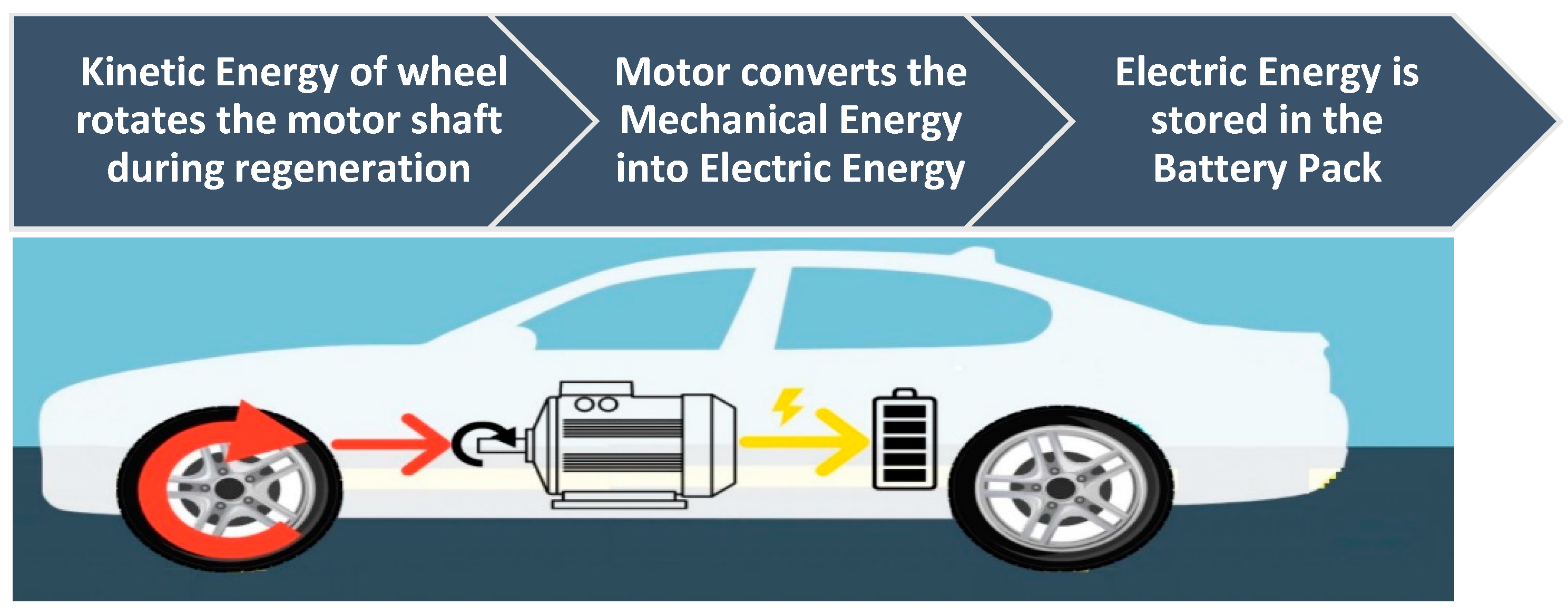

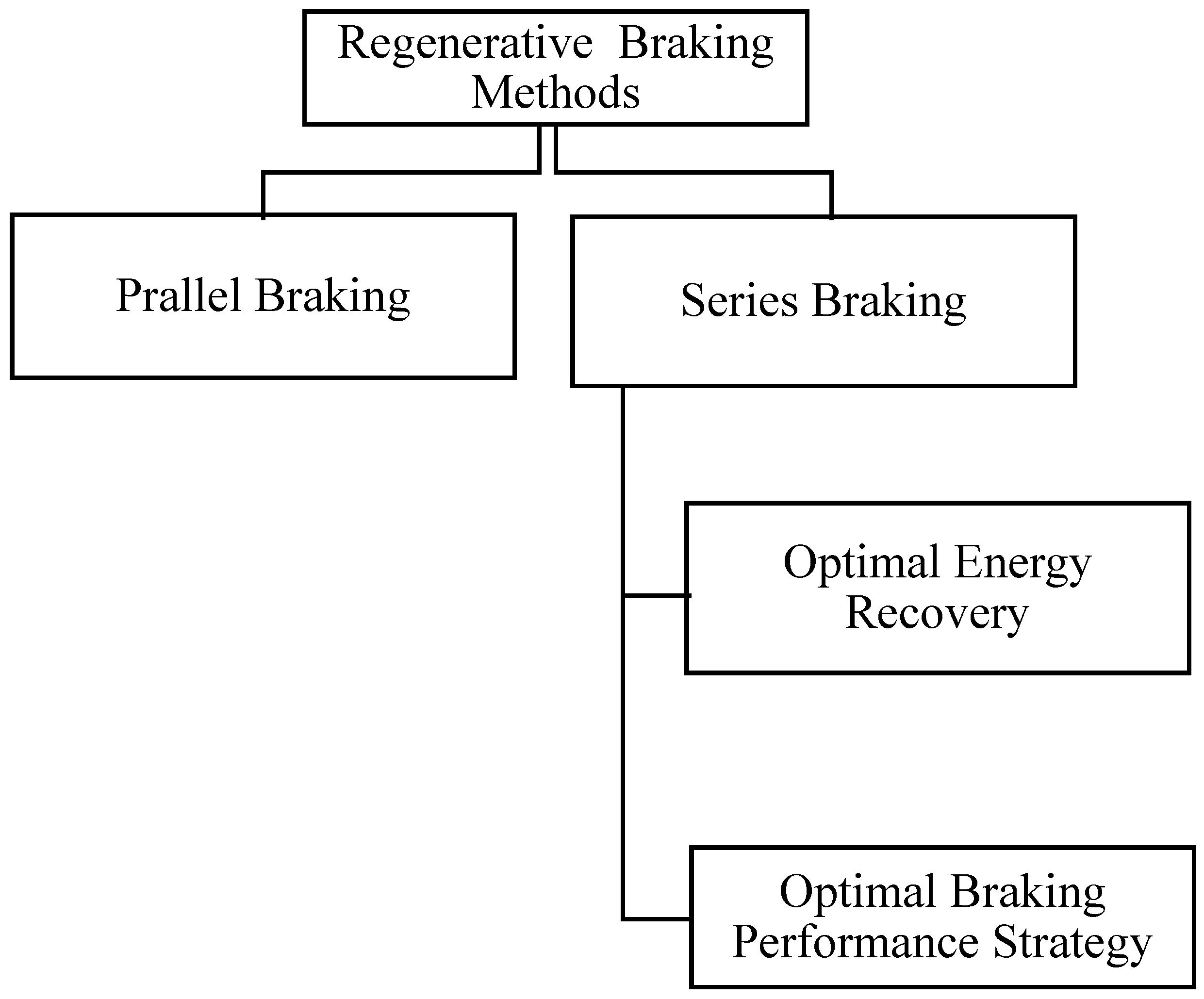
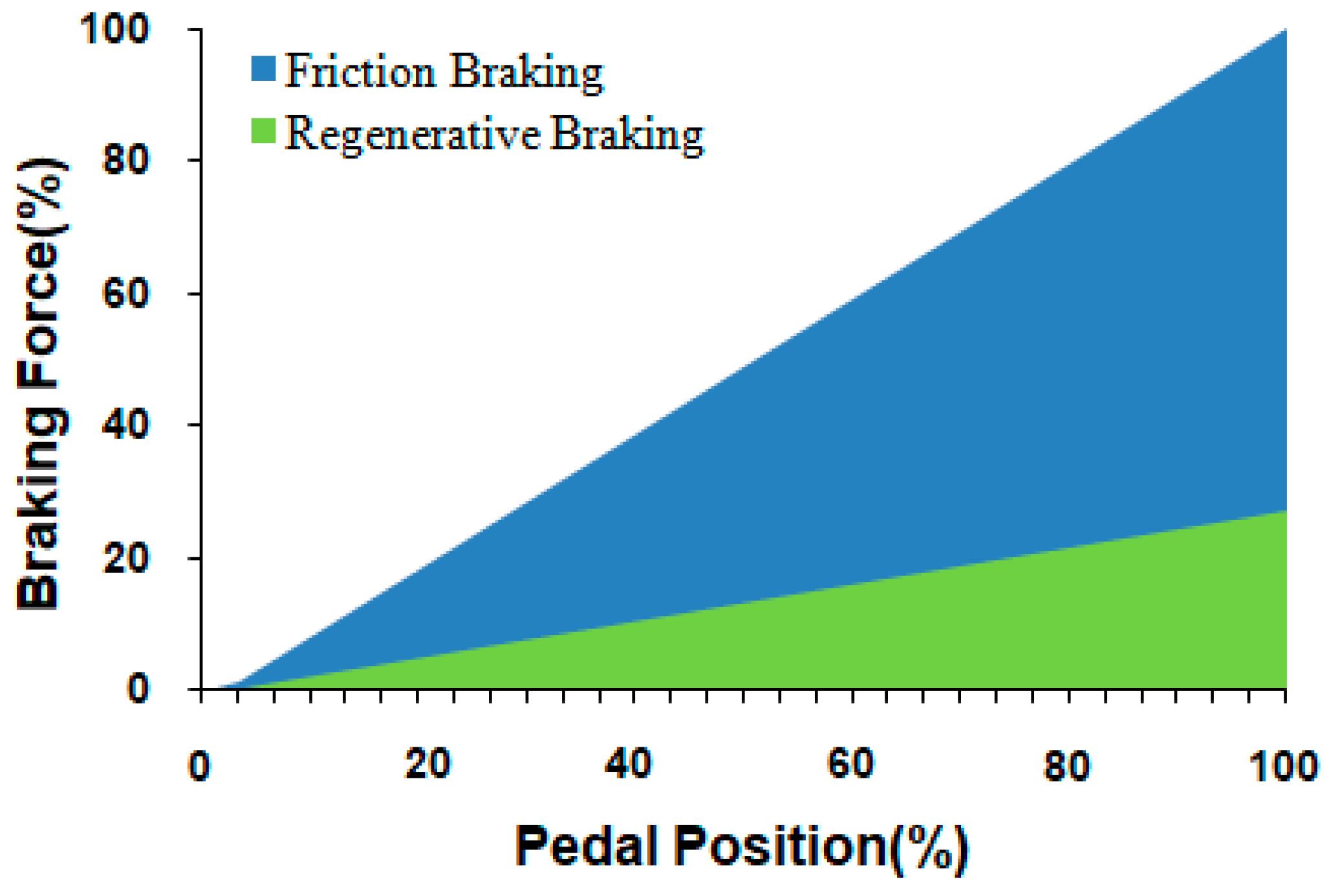


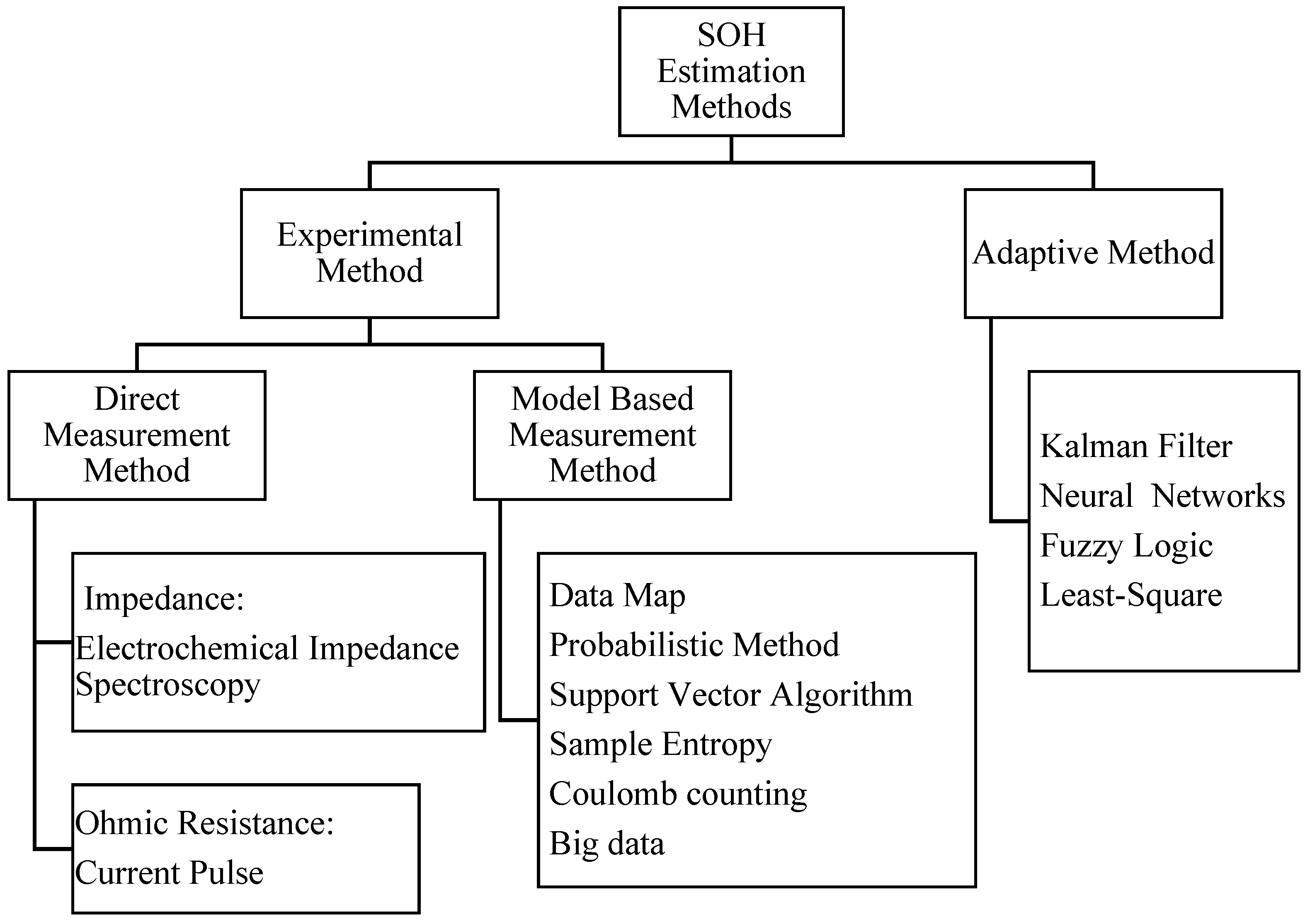

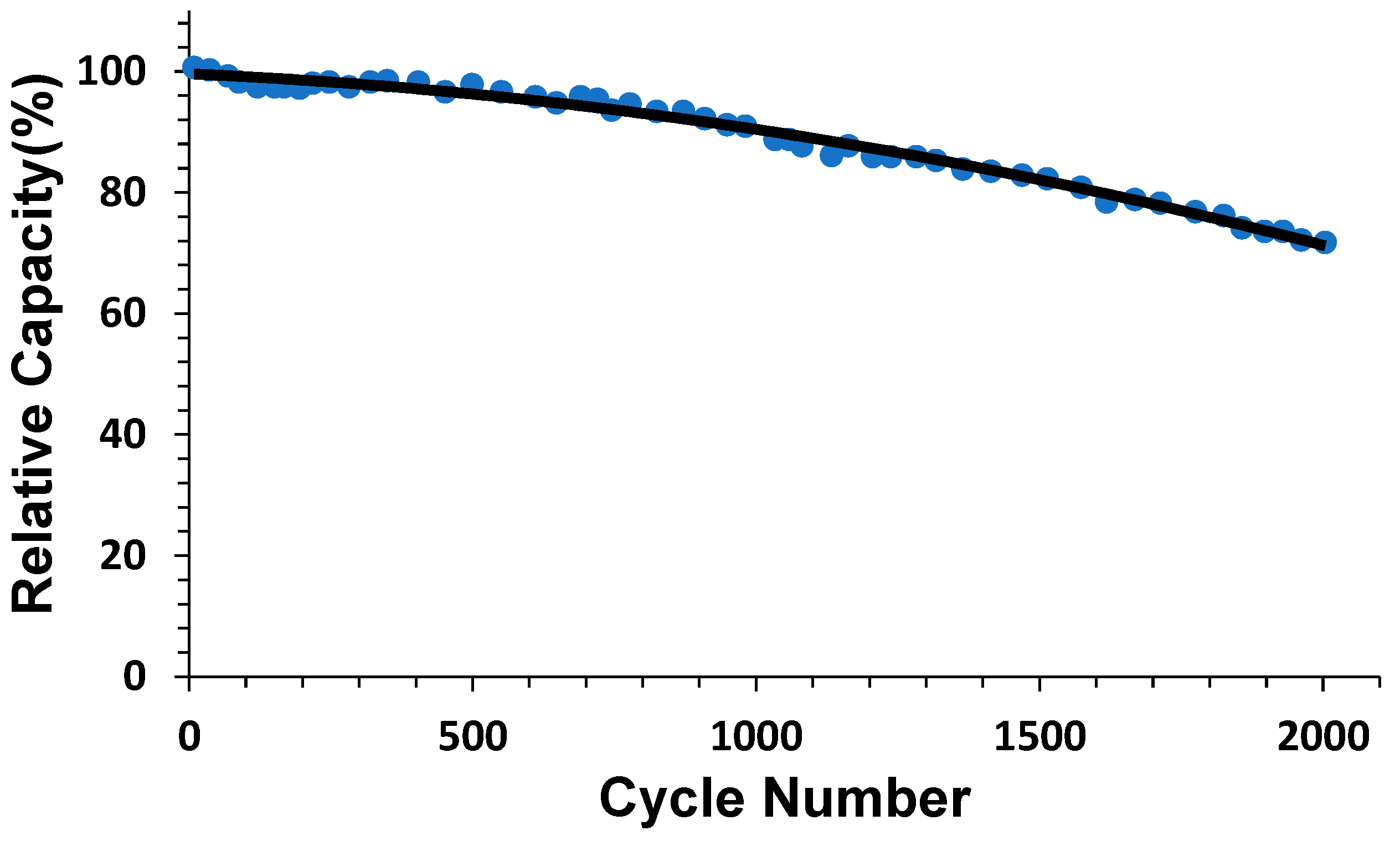
Disclaimer/Publisher’s Note: The statements, opinions and data contained in all publications are solely those of the individual author(s) and contributor(s) and not of MDPI and/or the editor(s). MDPI and/or the editor(s) disclaim responsibility for any injury to people or property resulting from any ideas, methods, instructions or products referred to in the content. |
© 2023 by the authors. Licensee MDPI, Basel, Switzerland. This article is an open access article distributed under the terms and conditions of the Creative Commons Attribution (CC BY) license (https://creativecommons.org/licenses/by/4.0/).
Share and Cite
Chidambaram, R.K.; Chatterjee, D.; Barman, B.; Das, P.P.; Taler, D.; Taler, J.; Sobota, T. Effect of Regenerative Braking on Battery Life. Energies 2023, 16, 5303. https://doi.org/10.3390/en16145303
Chidambaram RK, Chatterjee D, Barman B, Das PP, Taler D, Taler J, Sobota T. Effect of Regenerative Braking on Battery Life. Energies. 2023; 16(14):5303. https://doi.org/10.3390/en16145303
Chicago/Turabian StyleChidambaram, Ramesh Kumar, Dipankar Chatterjee, Barnali Barman, Partha Pratim Das, Dawid Taler, Jan Taler, and Tomasz Sobota. 2023. "Effect of Regenerative Braking on Battery Life" Energies 16, no. 14: 5303. https://doi.org/10.3390/en16145303
APA StyleChidambaram, R. K., Chatterjee, D., Barman, B., Das, P. P., Taler, D., Taler, J., & Sobota, T. (2023). Effect of Regenerative Braking on Battery Life. Energies, 16(14), 5303. https://doi.org/10.3390/en16145303











